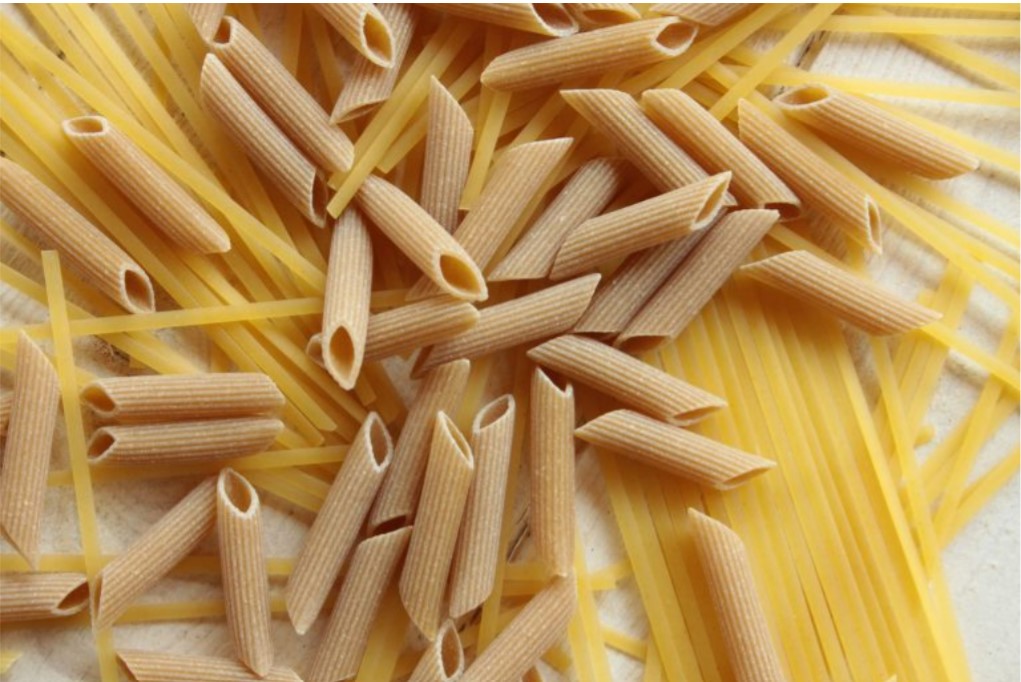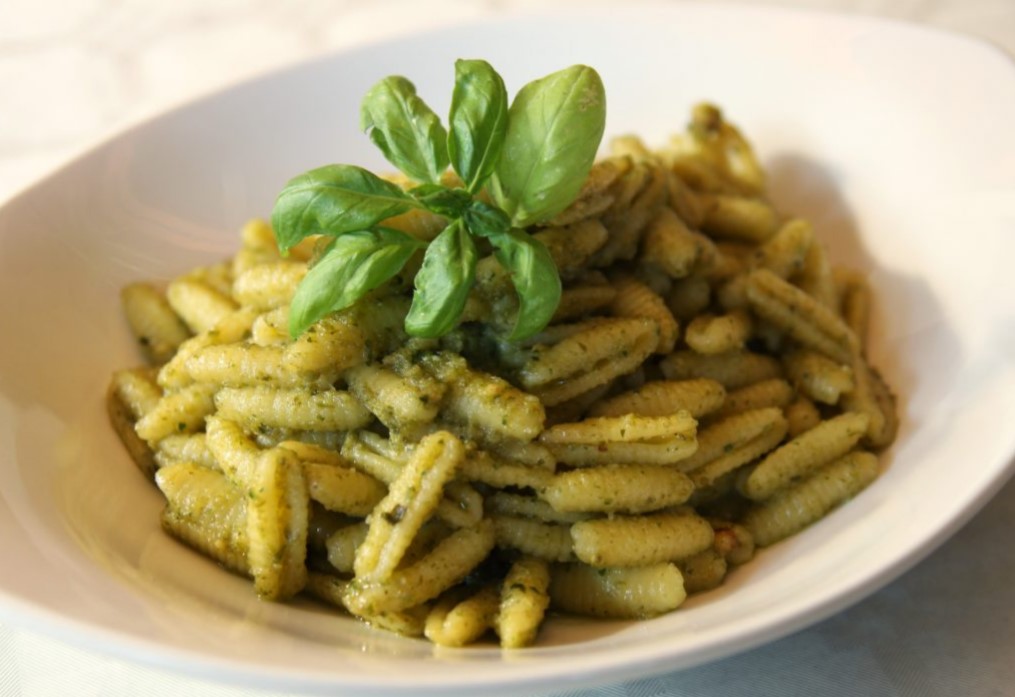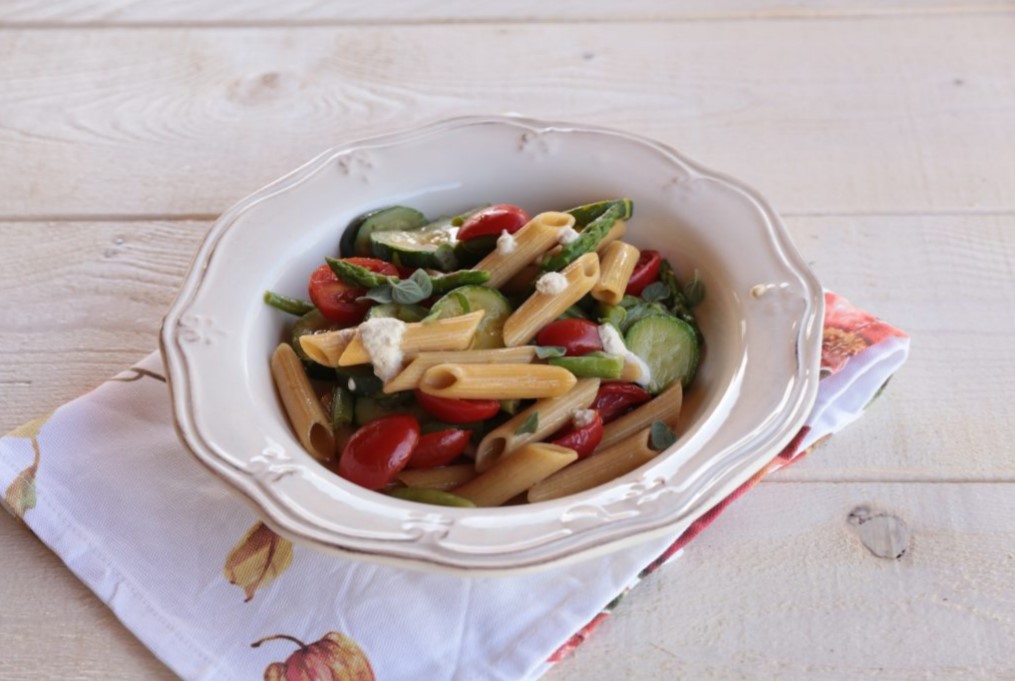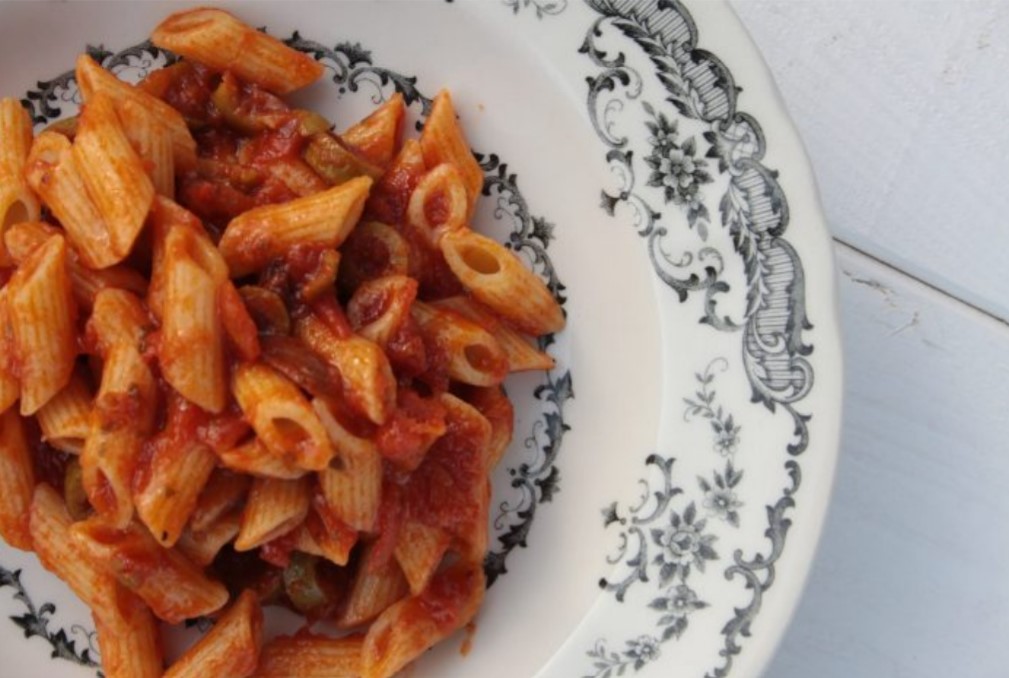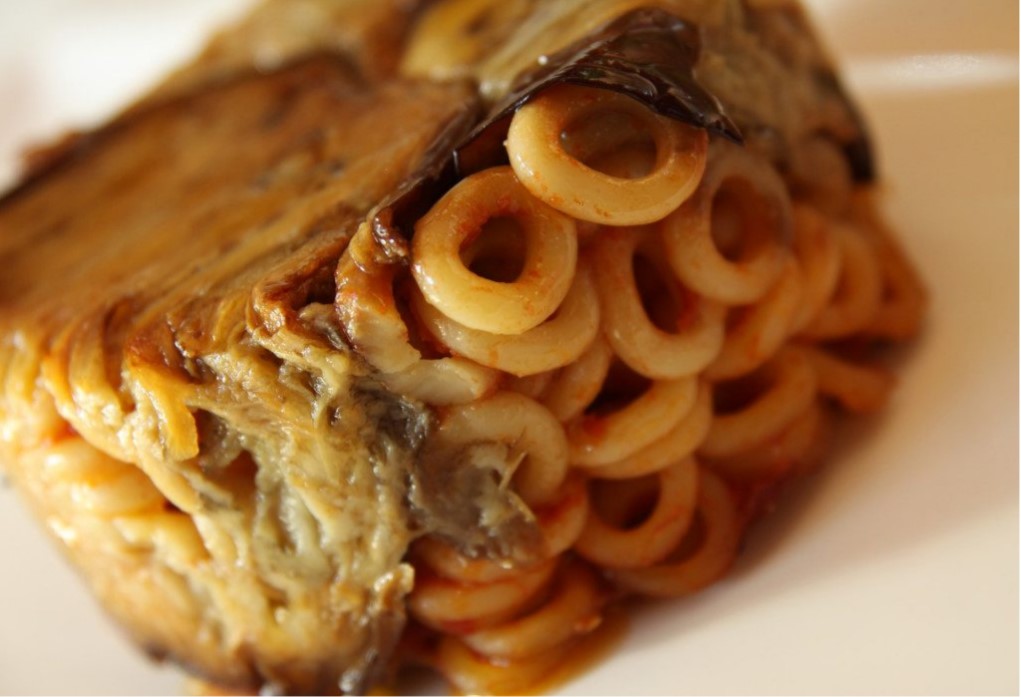Introduction
Pasta is an ancient food widely consumed in the world and represents one of the staple foods of the Mediterranean diet. There are many theories concerning its origin. Some researchers place its origin in the thirteenth century by Marco Polo, who introduced pasta in Italy upon returning from one of his trips to China in 1271. However, pasta dates much further back, maybe to the ancient Etruscans, who made pasta by grinding several cereals and grains and then mixing them with water, a blend that was later on cooked producing a tasty and nutritious food. The term ‘macaroni,’ which is currently referred to as a long type of pasta, is found in the documents of Roman writers since the first centuries ‘after Christ.’ However, both the Etruscans and the Romans baked their noodles in an oven, so boiled pasta had yet to be born in Italy. As the centuries went by, pasta continued to appear on the tables of Italy with different names. For example, in 1400, pasta was called ‘lasagna’ and pasta manufacturers were referred to as ‘lasagnare,’ while in 1800, their name turned into ‘vermicellai.’ Between 1400 and 1800, a new kind of pasta, that is, ‘fidelli,’ started being manufactured besides ‘lasagne’ and ‘vermicelli.’ ‘Fidelli’ were pasta threads with a cylindrical shape, and pasta manufacturers became known as ‘fidellai.’
According to the American historian Charles Perry, who has written several articles on the origins of pasta, the first clear western reference to boiled noodles is in the Jerusalem Talmud of the fifth century AD written in Aramaic for which the term ‘itriyah’ was used. By the tenth century, ‘itriyah’ in many Arabic sources referred to dried noodles bought from a vendor, as opposed to fresh ones made at home.
Pasta Ingredients and Production
Pasta is mainly produced with wheat flour and water: eggs and/or other optional ingredients can also be added. Pasta manufacturers typically use milled durum wheat (semolina) although soft wheat flour and other cereal flours are also used. pasta traditionally consumed in Italy is made exclusively with durum wheat flour, while in other countries, pasta made from soft wheat and/or other cereal flours are also frequently consumed. Durum wheat pasta is made from durum wheat semolina (Triticum turgidum L. var. durum) to which water is added, the reactant, that allows modification of gluten via the input of mechanical and thermal energy to produce pasta. Wheat proteins help with strengthening pasta structure by means of entangled aggregation. Starch, the major component of semolina and pasta, occurs in the form of granules dispersed within the protein network.
Pasta processing consists of three main operations: (1) hydrating and mixing–kneading of semolina to make a dough (formation of gluten network), (2) shaping the dough through extrusion, and (3) stabilizing the shaped pasta pieces, usually by drying. This sequence of operations is developed in an industrial automated scale. The process of hydrating and mixing–kneading of semolina produces a homogeneous hydrated dough that is essential for producing high-quality pasta. To obtain the most homogeneous hydrated mass, semolina and water first undergo high-speed premixing (using a single or double shaft, vertical or horizontal) to ensure intimate contact between semolina particles and water droplets. Further mixing then takes place in the main mixing unit, generally under vacuum, that removes air bubbles before the mass passes in the extrusion section.
After the dough is mixed, it is transferred to the extruder in order to obtain a specific form (spaghetti, macaroni, etc.) with the development of a continuous network of gluten proteinthat surrounds the starch granules. This process facilitates maintenance of pasta structure during cooking. The extrusion auger forces the dough through the die under high pressure, followed by cutting. The die holes are designed to give pasta the desired shape and size. Compression and extrusion are obtained with different machines. Until recently, most dies were made of bronze, which was relatively soft and required repair or periodic replacement. Recently, dies have been improved by fitting the extruding surface of the die with Teflon® inserts to extend the life of the dies and improve pasta quality.
Drying is the most difficult and critical step to control in the pasta production process. Drying consists of passing a flow of hot or warm air over the fresh pasta product, so that the thermohygrometric properties of the air progressively decrease the pasta moisture content at a level acceptable for dried pasta. Nowadays, the majority of pasta-drying processes adopt air temperatures in the range of about 70–100 °C while keeping product temperatures between 60 and 90 °C. The objective of drying is to lower the moisture content of pasta from ∼31% to 12–13%, so that the finished product is hard, retains its shape, and can be stored without spoiling. Dried pasta stored at room temperature is stable for years at room temperature.
The best pasta is produced from durum wheat semolina, due to the dough excellent rheological properties, pasta superior color, cooking quality, and consumer acceptance. Whole grain wheat and other grains such as rice, buckwheat, barley, spelt, millet, oats, quinoa, and corn are also sometimes used to make pasta, which can be made also from more than one type of grain, and, in such a case, it is called ‘multigrain.’
Pasta can be enriched, supplemented, or fortified or remain conventional. In recent years, several ingredients have been developed and are being used to improve the nutritional quality of pasta, for example, fibers, proteins, and vitamins.
On the basis of scientific evidence showing beneficial effects on health of whole grain product consumption, production of whole wheat pasta is increasing in recent years and many efforts have been made to improve its rheological and organoleptic properties and to implement its consumption even if this product is not yet widely consumed. Whole wheat pasta is significantly higher in fiber and nutrients than its refined counterpart: during the refining process, wheat loses roughly 60% of its grain, a portion that includes its most nutritious components, the bran and the germ. Consequently, refined wheat provides less than half the amount of B vitamins, minerals, and fibers than whole grains. At present, there are no food labeling regulations setting the minimum whole grain content required for a given food to be considered whole grain. The Whole Grains Council recommends manufacturers to label as ‘whole grain’ only products containing a higher percentage of whole grain than refined grain (i.e., at least 51% whole grain). The HEALTHGRAIN Forum proposes two labeling categories, one for bread and pasta indicating 100% whole grain if the content of whole grain flour is almost over 90% of dry material and the other category for foods defined as ‘rich in whole grain’ where the amount of whole grain must be specified.
Production and Consumption
The last report of the International Pasta Organization (IPO) () states that in 2012, about 13.5 million tons of dry pasta has been produced in the world. Among the pasta-producing countries, Italy ranks first with an annual production of about 3.33 million tons, followed by the United States (2.00 million tons), Brazil (1.19 million tons), Russia (1.08 million tons), and Turkey (1.00 million tons). The European Union produces 36.4% of pasta, followed by Central and South America with 21.9% and by North America with 16.9%; Asia and Australia are the countries with the lowest pasta production, that is, 1.8% and 0.4%, respectively. Italy is the first pasta-exporting country with about 1.8 million tons, followed by Turkey (436 thousand tons), Belgium (137 thousand tons), the United States (133 thousand tons), and China (109 thousand tons). Italy is the largest per capita/year pasta consumer in the world (26 kg), followed by Venezuela (13.2 kg), Tunisia (11.1 kg), and Greece (10.6 kg); Switzerland (9.2 kg) and Sweden (9.0 kg) consume more pasta per capita than the United States (8.8 kg).
Composition and Nutritional Qualities
Pasta is an important source of carbohydrates, especially starch. A portion of 100 g of uncooked pasta contains about 68.1 g starch, 4.2 g soluble sugars, 2.7 g fiber, 10.9 g protein, and 1.4 g fat, providing about 353 kcal (1478 kJ). pasta also contains vitamins B1 and B2, as well as some minerals. In the United States, however, pasta is vitamin- and mineralenriched. During cooking, some of the nutrients get lost either in the water or by heat, especially some starch, proteins, phosphorus, and vitamin B1.
The biological value of proteins in durum wheat pasta is not particularly elevated given its low content of essential amino acids: in particular, wheat proteins are deficient in lysine. Based on high or low temperature used in drying, 100 g of pasta contains from ∼22% to 26% lysine recommended dietary intake. However, pasta is usually consumed with other foods with different protein contents that improve the nutritional value of the pasta dish. The addition of eggs to the basic ingredients increases its protein content (about 20% higher compared to wheat pasta) and its biological value since eggs contain about 139% of the recommended dietary intake for lysine. However, the addition of eggs increases also the fat content of pasta.
Whole grain pasta contains fewer calories for 100 g of dry product (about 324 kcal per 1356 kJ) and supplies more fiber (∼6 g) and 25% more proteins than the traditional refined pasta. Whole grain pasta is an excellent source of B vitamins and iron and provides significantly higher levels of the essential trace mineral selenium, a micronutrient with antioxidant properties. Whole wheat pasta also contains appreciable levels of alpha-linolenic acid. The most common whole grain pastas are made from whole wheat, bsectionn rice, or buckwheat, but quinoa, spelt, and kamut are also used to make whole grain pasta. Not all whole grain pasta is made from 100% whole grain flour, however. Some are made from a mixture of whole grain flour and ground legumes and flax, ingredients that improve the product texture while boosting its protein and unsaturated fatty acid content.
Compared to wheat, buckwheat contains proteins with a high biological value due to a well-balanced amino acid composition (rich in lysine and arginine) and antioxidant molecules, such as rutin (a flavonol glycoside), which is recommended for people with capillary fragility. Corn pasta has about half as much proteins as traditional wheat pasta, but it is otherwise nutritionally comparable. pasta from rice flour does not contain any gluten. Bsectionn rice flour compared to white rice flour is made from rice that has only the inedible hull removed; therefore, it is high in fiber and produces pasta dough similar to whole wheat pasta, with the exception that dough made from bsectionn rice flour is stickier. This kind of pasta is consumed in Asian countries and available in Asian markets or health food stores. Compared to common wheat, the composition of the kamut grain is richer in several minerals, including magnesium and zinc and selenium, a powerful antioxidant. Compared to wheat flour, kamut flour is also characterized by a percentage of vitamin E higher than 30%, as well as a higher content of proteins, lipids, and fatty acids. Oat and barley flours are mixed with wheat flour because they are rich in beta-glucan, a type of viscous fiber that improves pasta texture. Soy flour can be used to supplement proteins in macaroni and to produce a quick-cooking pasta product. Spaghetti with high protein and high lysine content can be obtained by adding up to 35% soy flour without adverse effects on flavor and texture and could result in greater acceptability of a soy-based diet.
Among the different types of pasta, the inulin-enriched pasta is to be counted for its content of nondigestible fructooligosaccharide with prebiotic effects.
Starch is the most abundant nutrient in pasta and the source of rapidly released glucose during digestion, regardless of the type of cereal used. The starch of pasta contains two major glucose polymers, amylose and amylopectin, which differ in the degree of polymerization (DP) of glucose chains and in the frequency of branches. In particular, wheat endosperm contains ∼75–80% of starch as amylopectin and 20–25% as amylose. Amylose is a predominantly linear molecule with glucose chains linked through alpha-1,4 linkages in the range of 1000–2000 DP, while amylopectin is a complex and highly branched molecule in the range of 50000–500 000 DP. In amylopectin, glucose units are linked in a linear way with alpha-1,4 linkages. Branching takes place with alpha-1,6 bonds occurring every 24–30 glucose units, resulting in a soluble molecule that can be quickly degraded since it has many end points for enzymes to attach onto. In contrast, amylose contains very few alpha-1,6 bonds or even none at all. This causes it to be hydrolyzed more slowly but to have a higher density and to be insoluble. In raw products, native starch occurs naturally as insoluble semicrystalline granules assembled in some way to form an ordered granular architecture and is not digested by human bowel enzymes. When it is heated in excess water, the starch granules undergo an irreversible phase transition, referred to as gelatinization, in which the highly ordered structure is disrupted.
The extent of starch gelatinization is the key factor in determining the digestibility and nutritional properties of starchy foods. The starch, before being absorbed in the small intestine, must be hydrolyzed to its monosaccharide components. The digestion of starch begins with salivary amylase, but this activity is much less important than that of pancreatic amylase in the small intestine. Amylase hydrolyzes starch, with the primary end products being maltose, maltotriose, and alphadextrins; some glucose is also produced. The products of alpha-amylase digestion are hydrolyzed into their monosaccharide components by enzymes expressed on the brash border of the small intestinal cells, the most important of which are maltase, sucrase, isomaltase, and lactase. However, starch digestibility is influenced also by the physical structure of food. In the case of pasta, molecular rearrangements of proteins may lead to the formation of large proteinaggregates, which reduce pasta starch accessibility to the action of alpha-amylase during digestion that results in a lower but prolonged increase of blood glucose concentrations in the postprandial period. Addition of viscous fiber or inulin in pasta further reduces the rate of starch digestion.
Health Effects
Pasta is a key component of the traditional Mediterranean diet, a dietary pattern that confers health benefits compared to current Western dietary patterns.
Several decades of observational and intervention studies have clarified the characteristics of lifestyles able to prevent chronic diseases and extend longevity. It is well known that both an excess of calorie intake and an inappropriate composition of the habitual diet are relevant for the development of obesity and other chronic diseases. There is a general consensus among nutrition scientists and related experts concerning the optimal distribution of macronutrients: carbohydrates at 45–60% of calories, fats at 25–30% of calories, and proteins at 15–20% of calories. However, appropriate food choices may be more important than the overall amount of each of these macronutrients. This implies that avoiding extreme and/or unbalanced diets and favoring macronutrient-balanced eating patterns are as important as emphasizing the preferential use of unsaturated fats, whole grain and low-glycemic index (GI) foods, fiber-rich fruit and vegetables, and a combination of plant and animal proteinsources.
The GI is a measure of the blood glucose-raising ability of the available carbohydrates in foods. A large body of evidence shows that a diet with a low GI may be able to prevent weight gain and reduce the risk of type 2 diabetes and coronary heart disease. GI is calculated by dividing the incremental area under the curve (AUC) of blood glucose concentrations, measured after the ingestion of a portion of the test food by the AUC of blood glucose concentrations achieved with a portion of the reference food (glucose or white bread). The test and the reference food must contain the same amount (50 g) of carbohydrate and are evaluated in the same group. This index was proposed for the first time in 1981 by Jenkins as an alternative system for classifying carbohydrate-containing foods.
Among carbohydrate-rich foods, spaghetti has a lower GI than bread, pizza, and other cereal foods. The average GI of durum wheat spaghetti from different manufacturers, cooked 10–15 min in water, is 46%. Other types of durum wheat pasta (i.e., macaroni, penne, and fusilli) or fresh pasta, made from soft wheat flour and eggs, also have a low GI that ranges from 32% to 47%. These values are also superimposable to those of whole grain boiled spaghetti (42%) and soy spaghetti (47%). As mentioned earlier, the low GI of these products is consistent with a low rate of starch accessibility to digestion, due to the formation of large proteinaggregates surrounding the starch. This is relevant since it is able to reduce insulin secretion and consequently the risk of reactive hypoglycemia during the postabsorption period; moreover, it contributes to increase glucagon-like peptide-1 (GLP-1) that regulates postprandial satiety and glucose metabolism.
The majority of the intervention studies, mainly performed in high-risk subjects – obese subjects or people with insulin resistance/metabolic syndrome – and in diabetic patients, have shown that a low-GI diet induces favorable changes on body weight regulation, blood glucose, and insulin metabolism and lipid control.
A meta-analysis of randomized controlled trials has demonstrated that a diet with low GI, at least in the medium term (< 6 months), promotes a greater weight gain and total fatmass loss compared to diet with high GI. This result has also been confirmed by a systematic review in which the authors evaluated the independent role in body weight reduction of GI and other variables of diet in healthy subjects, in glucose-intolerant subjects, and in type 1 and type 2 diabetic patients.
Epidemiological evidence also suggests that a diet with a low GI and rich in fiber contributes to diabetes prevention and to an improvement of the plasma lipid profile. The benefits of low-GI foods on blood glucose control and other metabolic parameters are particularly evident in intervention studies performed in diabetic patients and in other high-risk individuals compared to healthy subjects. In relation to blood glucose control, data clearly show that in diabetic patients, low-GI/ high-fiber diets improve blood glucose concentrations, especially in the postprandial state, reduce the number of hypoglycemic events, and also lower the level of glycated hemoglobin. The beneficial metabolic effects of low-GI foods are independent of the fiber content. However, a combination in the diet of both low-GI and fiber -rich foods may enhance the beneficial effects of each component. These findings have led some food industries to develop new types of pasta rich in fiber, like those made from whole grain wheat flour or barley and oat flour. In particular, pasta made from whole grain wheat flour, beyond its content of dietary fiber, is also rich in oligosaccharides, minerals, vitamins, and antioxidant components that may have an additional beneficial influence on several biological functions. As a matter of fact, the habitual consumption of whole grain foods is consistently associated with reduced risk of developing obesity, type 2 diabetes, and cardiovascular diseases in several epidemiological studies. These benefits have been related to multiple mechanisms; worth considering are (1) the lower energy content of whole grain products, as well as the higher satiating effect, favoring a lower energy intake per eating occasion and, in the long term, playing an important role in body weight regulation, and (2) the higher fiber, resistant starch, and oligosaccharide content fermented by gut microbiota with production of short-chain fatty acids (SCFA), as acetic, propionic, and butyric acids, which improve the control of glucose and lipid metabolism, decrease gastric emptying rate, and increase satiety. In particular, an intervention study, performed in subjects with the metabolic syndrome, showed that whole grain wheat pasta consumed in the context of a mixed meal significantly reduces postprandial insulin and triglyceride plasma levels, compared to refined cereal products. For these reasons, the consumption of whole grain foods in the diet has been included in the nutritional recommendations of the United States and other countries as a dietary strategy targeting the whole population.
Beneficial effects on glucose and lipid metabolism have been also reported in subjects consuming pasta made from barley or oat flour, two cereals particularly rich in beta-glucan, or pasta added with guar. These types of pasta, compared to traditional refined wheat pasta, induced an even lower increase of plasma glucose, insulin, and triglyceride levels in the postprandial period and decreased even more both fasting and postprandial plasma cholesterol concentrations. The benefits on glucose metabolism of barley and oat pasta are related to the high viscosity of beta-glucans, which delays gastric emptying and limits starch accessibility to digestive enzymes, thus prolonging nutrient digestion and absorption in the small intestine.
Finally, consumption of pasta enriched in fructooligosaccharides and inulin has been proposed as a useful tool to prevent inflammatory gastrointestinal diseases and colon cancer, thanks to its prebiotic effects. The prebiotic activity might have a beneficial impact also on fat storage, insulin resistance, and subclinical inflammation.
However, despite the potential health benefits of new pasta formulations, it needs to be underlined that the types of pasta commonly available in food shops represent a healthy choice among carbohydrate-rich foods for their low GI and high satiating ability. Moreover, according to the Mediterranean tradition, pasta is the main ingredient of a complex dish in which other ingredients are also present, among these being olive oil, vegetables such as tomatoes, and products of animal origin. When animal products like fish, cheese, and meat are present in the dish, their amount is usually small and it can be considered optimal from the nutritional standpoint, being a good source of low-GI carbohydrates, rich in fiber, and with a balanced content of high-quality proteins and unsaturated fats, not to mention micronutrients and polyphenols.
In conclusion, scientific evidence supports the health benefits of regular pasta intake, in particular if it is consumed in the context of a diet balanced for energy density and macronutrient distribution, according to the Mediterranean dietary pattern. In fact, pasta, due to its low GI, represents an ideal source of carbohydrates in the diet of healthy individuals, obese subjects, and diabetic patients. In this context, the alarm about the possible dangers of a high consumption of dietary carbohydrates certainly does not apply, on the basis of the available scientific evidence, to healthy carbohydrate-rich foods like pasta. In contrast, it is strongly advised to favor pasta consumption, in those countries where its consumption is low, in substitution of other carbohydrate foods with higher GI. Furthermore, in order to enhance whole grain intake in the daily diet, whole grain pasta consumption should be considered in addition or in substitution of refined grain pasta.
See also:
Carbohydrate: Digestion, Absorption and Metabolism; Cereals: Dietary Importance; Cereals: Types and Composition; Dietary Fiber: Bran; Dietary Fiber: Determination; Glucose: Metabolism and Regulation; Gut Hormones; Obesity: The Role of Diet; pasta: Manufacture and Composition; Starch: Modified Starches; Starch: Sources and Processing; Starch: Structure, Property, and Determination; Starch; Wheat: Grain Structure of Wheat and Wheatbased Products.Further Reading
- Atkinson FS, Foster-Powell K, and Brand-Miller JC (2008) International tables of glycemic index and glycemic load values: 2008. Diabetes Care 31: 2281–2283.
- Casiraghi MC, Pagani MA, Erba D, Marti A, Cecchini C, and D’Egidio MG (2013) Quality and nutritional properties of pasta products enriched with immature wheat grain. International Journal of Food Sciences and Nutrition 64: 544–550.
- Castro-Quezada I, Roma´n-Vin˜as B, and Serra-Majem L (2014) The Mediterranean diet and nutritional adequacy: a review. Nutrients 6: 231–248.
- Fardet A (2010) New hypotheses for the health-protective mechanisms of whole-grain cereals: what is beyond fibre? Nutrition Research Reviews 23: 65–134.
- Giacco R, Della Pepa G, Luongo D, and Riccardi G (2011) Whole grain intake in relation to body weight: from epidemiological evidence to clinical trials. Nutrition, Metabolism, and Cardiovascular Diseases 21: 901–908.
- Giacco R, Costabile G, Della Pepa G, et al. (2014) A whole-grain cereal-based diet lowers postprandial plasma insulin and triglyceride levels in individuals with metabolic syndrome. Nutrition, Metabolism, and Cardiovascular Diseases 24: 837–844.
- Harris KA and Kris-Etherton PM (2010) Effects of whole grains on coronary heart disease risk. Current Atherosclerosis Reports 12: 368–376.
- Ley SH, Hamdy O, Mohan V, and Hu FB (2014) Prevention and management of type 2 diabetes: dietary components and nutritional strategies. Lancet 383: 1999–2007.
- Livesey G, Taylor R, Hulshof T, and Howlett J (2008) Glycemic response and health—a systematic review and meta-analysis: relations between dietary glycemic properties and health outcomes. The American Journal of Clinical Nutrition 87: 258–268.
- Mancini M, Ordovas JM, Riccardi G, Rubba P, and Strazzullo P (eds.) (2011) Nutritional and metabolic bases of cardiovascular disease. UK: Wiley-Blackwell.
- Pollini CM, Panto` F, Nespoli A, Sissons M, and Abecassis J (2012) Manufacture of pasta products. In: Sissons M, Abecassis J, Marchylo B, and Carcea M (eds.) Durum wheat chemistry and technology, 2nd ed., pp. 161–175. St. Paul, MN: AACC International.
- Riccardi G, Rivellese AA, and Giacco R (2008) Role of glycemic index and glycemic load in the healthy state, in prediabetes, and in diabetes. The American Journal of Clinical Nutrition 87: 269–274.
- Sissons M, Abecassis J, Marchylo B, and Carcea M (eds.) (2012) Durum wheat chemistry and technology, 2nd ed. St. Paul, MN: AACC International.
- Slavin J (2013) Fiber and prebiotics: mechanisms and health benefits. Nutrients 22: 1417–1435.
- Wolever TM (2013) Glycemic index claims on food labels: review of Health Canada’s evaluation. European Journal of Clinical Nutrition 67: 1229–1233.
Relevant Websites
www.health.gov/DietaryGuidelines– HHS and USDA guidelines – Health and Human
Services.
www.internationalpasta.org/index.aspx – International Pasta Organization.
